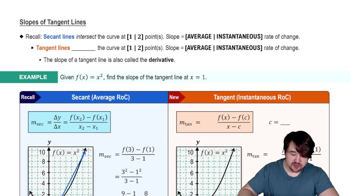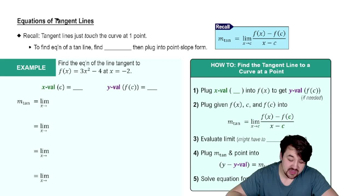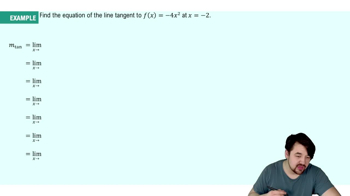Table of contents
- 0. Functions7h 52m
- Introduction to Functions16m
- Piecewise Functions10m
- Properties of Functions9m
- Common Functions1h 8m
- Transformations5m
- Combining Functions27m
- Exponent rules32m
- Exponential Functions28m
- Logarithmic Functions24m
- Properties of Logarithms34m
- Exponential & Logarithmic Equations35m
- Introduction to Trigonometric Functions38m
- Graphs of Trigonometric Functions44m
- Trigonometric Identities47m
- Inverse Trigonometric Functions48m
- 1. Limits and Continuity2h 2m
- 2. Intro to Derivatives1h 33m
- 3. Techniques of Differentiation3h 18m
- 4. Applications of Derivatives2h 38m
- 5. Graphical Applications of Derivatives6h 2m
- 6. Derivatives of Inverse, Exponential, & Logarithmic Functions2h 37m
- 7. Antiderivatives & Indefinite Integrals1h 26m
2. Intro to Derivatives
Tangent Lines and Derivatives
Problem 42a
Textbook Question
Derivatives and tangent lines
a. For the following functions and values of a, find f′(a).
f(x) = 1/3x-1; a= 2
 Verified step by step guidance
Verified step by step guidance1
Step 1: Identify the function f(x) = \frac{1}{3}x - 1 and the point a = 2 where you need to find the derivative f'(a).
Step 2: Recall that the derivative f'(x) of a linear function f(x) = mx + b is simply the coefficient m of x. In this case, f(x) = \frac{1}{3}x - 1, so the derivative f'(x) is \frac{1}{3}.
Step 3: Since the derivative of a linear function is constant, f'(x) = \frac{1}{3} for all x. Therefore, f'(a) = f'(2) = \frac{1}{3}.
Step 4: Interpret the result: The derivative f'(a) = \frac{1}{3} represents the slope of the tangent line to the graph of f(x) at the point where x = 2.
Step 5: Conclude that the slope of the tangent line at x = 2 is \frac{1}{3}, which means the line rises \frac{1}{3} unit for every 1 unit it moves to the right.
Recommended similar problem, with video answer:
 Verified Solution
Verified SolutionThis video solution was recommended by our tutors as helpful for the problem above
Video duration:
4mPlay a video:
Was this helpful?

 5:13m
5:13mWatch next
Master Slopes of Tangent Lines with a bite sized video explanation from Nick
Start learningRelated Videos
Related Practice




